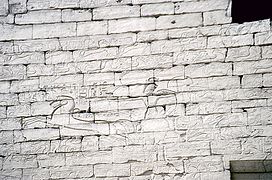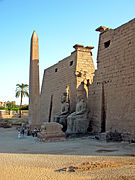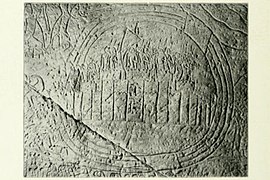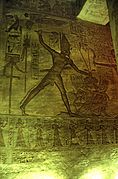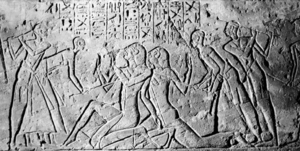
The Kadesh inscriptions or Qadesh inscriptions are a variety of Egyptian hieroglyphic inscriptions describing the Battle of Kadesh (1274 BC). The combined evidence in the form of texts and wall reliefs provide the best documented description of a battle in all of ancient history.
The Egyptian version of the battle of Kadesh is recorded in two primary accounts, known as the Bulletin or Report and the Poem which are often placed side by side in the locations they were inscribed. In addition, some reliefs also inscribed in the same location offer pictorial depictions of the battle. Some scholars divide these accounts into three. The Bulletin is repeated seven times and the Poem eight times, spread across temples in Abydos, Temple of Luxor, Karnak, Abu Simbel and the Ramesseum, and two hieratic papyri.
Poem
The Poem of Pentaur (pntAwr.t), usually short referred to as the Poem is known from eight inscriptions, and lists the peoples which went to Kadesh as allies of the Hittites. Amongst them are some of the Sea Peoples and many of the other peoples who would later take part in battles of the 12th century BC (see Battle of Kadesh).
The Poem has been questioned as actual verse, as opposed to a prose account similar to what other pharaohs had recorded.
Bulletin
The Bulletin or the Record is itself simply a lengthy caption accompanying the reliefs.
Eight copies survive today on the temples at Abydos, Karnak, Luxor and Abu Simbel, with reliefs depicting the battle.
Other inscriptions
In addition to these lengthy presentations, there are also numerous small captions used to point out various elements of the battle.
Outside of the inscriptions, a hieratic copy of the Poem is preserved in the Raifet-Sallier papyrus, of which the first page is lost, the second page ("Papyrus Raifet") is in the Louvre and the third page ("Papyrus Sallier III") is in the British Museum. However, this is "an inaccurate copy of the whole text".
Cuneiform references to the battle have been found at Hattusa, including a letter from Ramesses to Hattusili III written in response to a scoffing complaint by Hattusili about the pharaoh's victorious depiction of the battle. However, no annals have been discovered that might describe it as part of a campaign. Instead, there are various references made to it in the context of other events.
Copies
Poem
- Luxor Temple pylon, north side of both towers
- Karnak, outside the south wall of the Great Hypostyle Hall
- Abydos: Ramesses II temple
Bulletin
- Abu Simbel: Great Temple north wall of the first hall
- Ramesseum, west side of first pylon
- Luxor Temple pylon, south side
Reliefs
- Abydos: Ramesses II temple, outside walls
- Ramesseum, first pylon
- Ramesseum, second pylon
- Karnak
- Luxor Temple pylon:
- Temple of Derr
- Abu Simbel: Great Temple north wall of the first hall
Gallery
See also
References
- Ockinga 1987, p. 38: "No battle fought in antiquity is so well-documented as the clash between the Egyptians and the Hittites before the city of Kadesh on the Orontes in 1275 BC"
- ^ Lichtheim 1973, p. 57: "Subsequently the campaign was told al length in two separate accounts which scholars have called the Bulletin (or the Record) and the Poem. The two accounts are supplemented by pictorial reliefs with explanatory captions. The whole composition offers a number of striking features. First the fact that there are two distinct though overlapping accounts. Second the fact that the two versions were not merely carved once on the walls of a temple but were repeated in multiple copies – the Bulletin seven times and the Poem eight times. They are inscribed on the walls of the temples of Abydos, Luxor, Karnak, Abu Simbel and the Ramesseum, and the Poem is also found on fragments of two hieratic papyri.
- Gardiner, Alan, The Kadesh Inscriptions of Ramesses II (1975) pp. 2–4. However, Miriam Lichtheim, Ancient Egyptian Literature, Vol. 2: The New Kingdom (1978) p. 58, maintains that the Poem is truly just that, contra Gardiner, and prefers to maintain the older tripartite division of the documentation.
- Transactions: The Third Sallier Papyrus. 1874. p. 84.
- Breasted, James Henry, Ancient Records of Egypt: Historical Documents (1906) p. 58.
- Gardiner, p. 2
- Kitchen, Kenneth A., Ramesside Inscriptions, Notes and Comments Volume II (1999) pp. 13ff.
- Breasted 1903, p. 84, n.19.1: "The Luxor copy occupies the lower portion of the front (north side) of both towers of Ramses II's pylon... The inscription was partially cleared by Mariette, which permitted E. de Rouge to copy "
- Breasted 1903, p. 84 n.20: "All these texts, including the hieroglyphic, were once combined by E. de Rouge and published after his death by J. de Rouge (Rev. e.g., III–IX) ."
- Breasted 1903, p. 84, n.19.2: "The Karnak copy is on the outside of the south wall of the great hypostyle hall. "
- Breasted 1903, p. 84, n.19.3: "The Abydos copy on the walls of Ramses II's mortuary temple there has preserved only the lower ends of the lines, as the walls are destroyed except the last few courses."
- Breasted 1903, p. 85, n.21.1: "Abu Simbel – In the great rock temple on the north wall of the first hall over the battle reliefs. It was published by Champollion (Mon., 27–9), by Rossellini (Mon. stor., 100–102), and by Lepsius (LD., Ill, l87c–e). The original itself is very careless, the scribe having omitted the lower two-thirds of 1. 7 and beginning of 1. 8 (Ramesseum numbering)."
- Breasted 1903, p. 85, n.21.2: "Ramesseum – Over the battle reliefs on the rear (west) side of the first pylon. It was published by Sharpe (Eg. Inscr. 2d part 52), and by Lepsius (LD., III, 153). It is the best of all the texts, though Lepsius's copy needs some correction."
- Breasted 1903, p. 85, n.21.3: "3. Luxor. – On the rear (south side) of Ramses II's pylon... But these modern buildings of the natives have never been removed, and we have only a copy of the visible fragments by Brugsch (Rec. de mon., II, 53)"
- Breasted 1903, p. 86, n.22.1: "Abydos. – On the outside of the north, west, and south walls of the temple of Ramses II. Nearly the whole has perished, as only the lower courses of the walls remain. The short inscriptions were published by Mariette (Abydos II, pp. 10–11)"
- Breasted 1903, p. 86, n.22.2: "Ramesseum, First Pylon. – Champ., Not. Descr., I, 870–72"
- Breasted 1903, p. 86, n.22.3: "Ramesseum, Second Pylon. – Champ., Mon., 328–30; Not. Descry. 585–89, 873, 874"
- Breasted 1903, p. 86, n.22.4: "Karnak. – Chiseled out in antiquity; published infra, pp. 45, 46, and Plate VIII."
- Breasted 1903, p. 86, n.22.5: "Luxor – On pylon of Ramses II.; Champ., Mon., 323, 324, 327–327 (last two incorrectly marked Ramesseum)"
- Breasted 1903, p. 86, n.22.6: "Derr – Now destroyed, but seen by Champollion, Weidemann, Aeg. Gesch., 434, n. 5"
- Breasted 1903, p. 86, n.22.7: "Abu Simbel – In the great temple, first hall, north wall; Champ Mon., 17 bis-33; Not. Descr., I, 64–66"
Bibliography
- Breasted, James Henry (1903). The battle of Kadesh : a study in the earliest known military strategy.
- Ockinga, Boyo (1987), "On the Interpretation of the Kadesh Record", Chronique d'Égypte, 62 (123–124): 38–48, doi:10.1484/J.CDE.2.308740
- Gardiner, A.H. 1960. The Kadesh Inscriptions of Ramesses II. Oxford
- Thomas Charles Hartman (1967). The Kadesh Inscriptions of Ramesses II: An Analysis of the Verbal Patterns of a Ramesside Royal Inscription. Brandeis University.
- Anthony John Spalinger (2002). The Transformation of an Ancient Egyptian Narrative: P. Sallier III and the Battle of Kadesh. Otto Harrassowitz Verlag. ISBN 978-3-447-04355-7.
- Lichtheim, Miriam (1973). "The Kadesh Battle Inscriptions of Ramses II". Ancient Egyptian Literature: The late period. University of California Press. pp. 57–. ISBN 978-0-520-03615-4.

